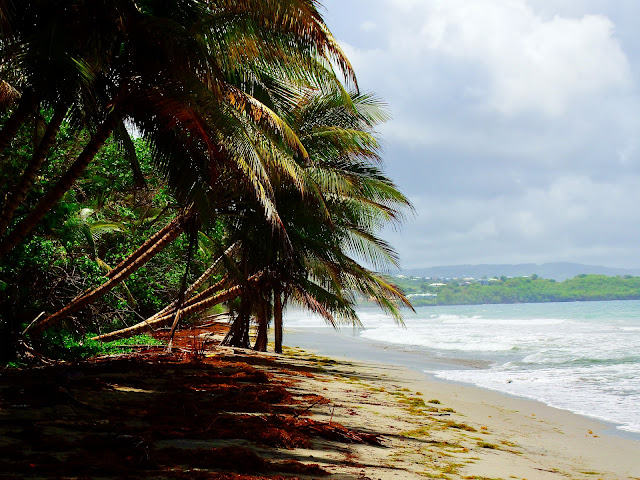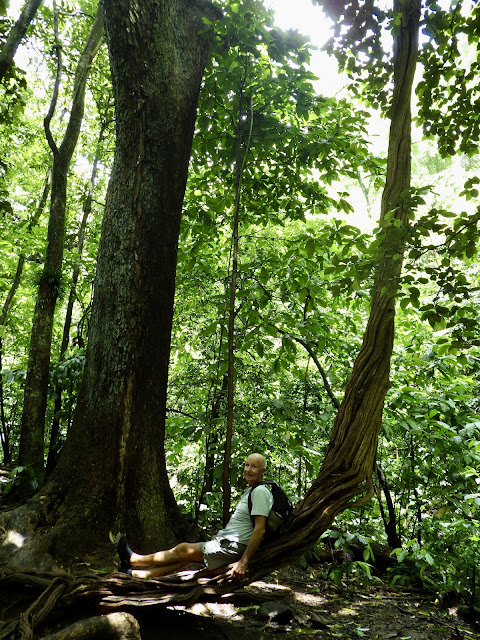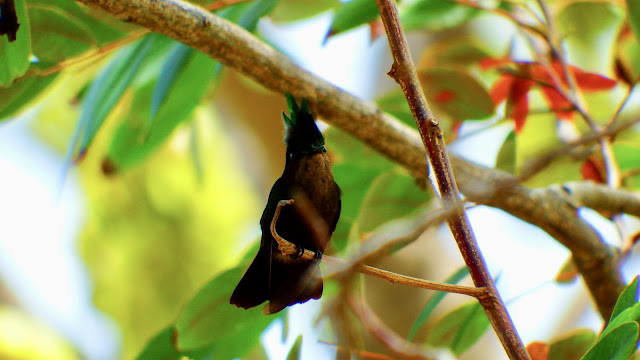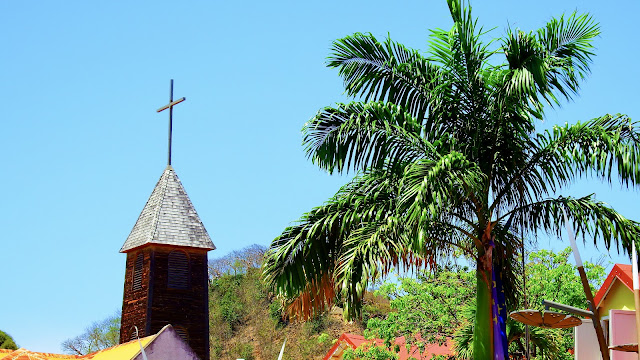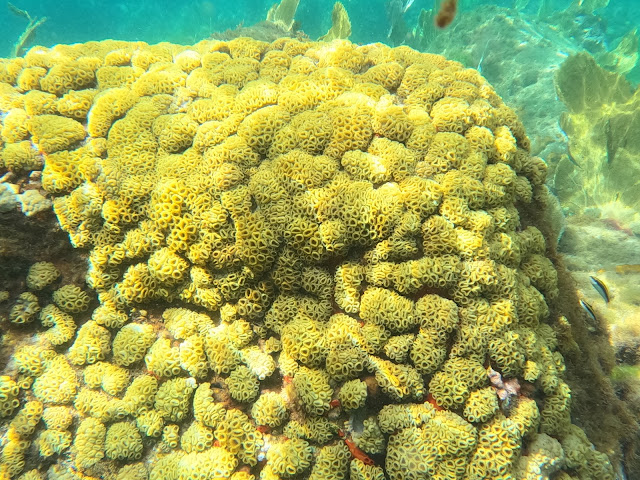On May 6, 2025, we left Terre de Haut, Guadeloupe to travel 45 miles south to Dominica. Our plan was to pick up a mooring, for one night, just south of Roseau, then continue 60 miles the next morning to Fort de France, Martinique. This plan worked out perfectly, only because we had met a couple in Guadeloupe who told us about the moorings in Roseau. The town of Portsmouth on the northwest side of the island offers an anchoring opportunity, but if you want to stop farther south anchoring is not really an option.
The island of Dominica is made up of several active volcanoes, and the west coast is extremely deep right up the island. The mooring we tied to was in 85 ft of water, and that is one of the most shallow spots on the west side of the island. Our swim that afternoon was in deep topaz blue water…that I must admit felt a little eerie. I have only seen that color in deep open ocean waters, so swimming in it was strange.
For some unknown reason, our Garmin InReach stopped updating our location between Dominica and Martinique. We didn’t intentionally go ‘dark’🤷♀️
Entering Fort de France was beautiful!
We anchored close to a very old, and large, fort. I didn’t find a lot of information on this location, but it looks like it is currently being used for military purposes.
This is the Google Earth view of the ‘old’ fort.
We stayed in Fort de France for 11 days, which is a little longer than we usually spend in one location, but again, weather was not cooperating for us to continue south so we used the time to rent a car and explore.
Note to self: research the meaning of street signs, in foreign countries, before renting a car!
Our explorations always provide new discoveries that require some research, to understand. We keep on ongoing list of questions to look up when we return to the boat. This trip was no different…the list was long🤣
Why are there bags on the bananas?
Bananas are often bagged to protect them from pests, diseases, and environmental damage during the growing process. The bags also create a micro climate that can help regulate temperature and humidity, potentially affecting the ripening process and increasing fruit quality.
(This was an AI overview that was consistent with my research, so I went with it)
Our first stop was at this memorial, located at the southern end of Martinique. I was truly impressed with the culture of Martinique, and their direct expression of art and history, in a way that highlights and owns the role of slavery, and thus the tragedy of slavery, in the island’s history.
What is the Anse Cafard Slave Memorial?
It was illegal to import new slaves into the Caribbean as of 1815. That, however, did not stop the illicit trade from continuing years later. To circumvent the law, traders simply snuck into port in the middle of the night. This, predictably, often yielded tragic results...
On the night of April 7, 1830, a slave ship sank in the rocky waters off the coast of Le Diamant near Diamond Rock. More than 40 would-be slaves, shackled together in the ship's hull, drowned.
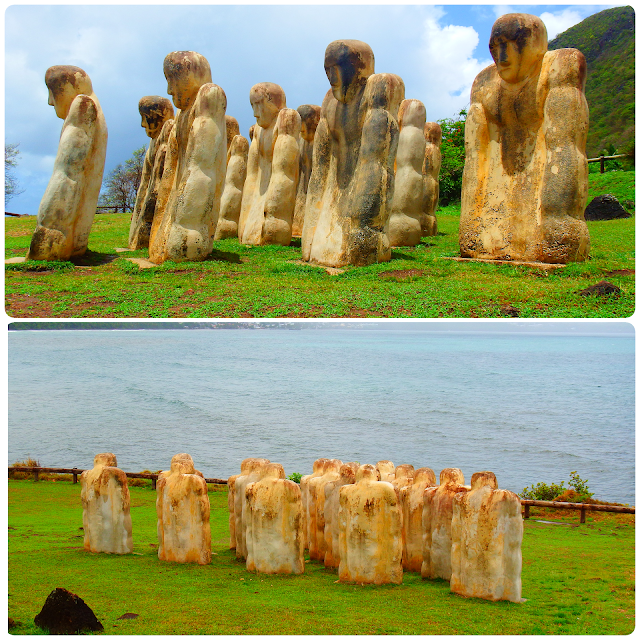
The Anse Cafard Slave Memorial is the masterwork of famed Martinican sculptor Laurent
Valére. It was completed in 1998 to commemorate the 150th anniversary of emancipation in the French West Indies. The Memorial is comprised of 15 statues made of cast concrete and sand. They're arranged in a triangle in reference to the triangular trade and stand at an angle of 110°, directly in line with the Gulf of Guinea. Each statue stands eight feet tall. These are large, hulking figures bearing stoic, brooding expressions. Shoulders hunched and heads bowed, the figures stare out to sea from what is an otherwise peaceful and breezy field. (UncommonCaribbean.com)
After visiting the memorial, we stopped at diamond beach.
Rocher du Diamant - Diamond Island
On the east side of the island we explored Habitation Clement. This place is huge, and one could easily spend the whole day exploring. The grounds are massive, with outdoor and indoor art museums. There are several building that house all of the old rum making machinery, and are designed as a walk through museum.
This tree does NOT want to be climbed! These huge spears come to a needle like point, and the base of the trunk and the tops of all branches are thickly covered😬
There was a LOT of old machinery, and Keith took pictures of each item. Will we ever look at those pics again? Probably not, but I say thank goodness for digital cameras!!
The smell in the aging barns was intoxicating…I’m pretty sure we got a little tipsy standing there🤣
Some very talented birds added to this piece, but they also put these nests in very high Royal Palms that apparently got blown out during recent high winds. There were about 30 of these nests on the ground, but they didn’t show any signs of habitation.
And finally at the end of the tour, you end up in the tasting room…and they have a LOT of flavors to taste! Patricia called it correctly, we left with 10 bottles😳…let me clarify, not 10 bottles of pure rum, only 2 bottles of pure rum, and 8 bottles of various rum punch flavors.
The next day, we decided to hike to the waterfall - Cascade de la rivière Couleuvre. The waterfall is in a rainforest, and it was an amazing hike!
Again, since we have Starlink, we never buy SIM cards in different countries, but this means we don’t have cell service when off the boat. However, my navigation app works with the gps in my iPad to track my location. This time, it really came in handy to make sure we were still on the trail, and heading in the correct direction (we are the boat)👍
The bamboo was unbelievable
Rainforest trees with massive buttress roots, like the Kapok tree (Ceiba pentandra), are adapted to shallow, nutrient-poor soils and are often emergent, towering above the forest canopy. These trees, found in tropical rainforests worldwide, develop large, flanged extensions at the base of their trunks to provide stability and support, especially in areas prone to flooding or strong winds (AI overview)
Vines wrapped around each other to make this fabulous hammock.
So many things I have never seen before…
And the waterfall was spectacular!
The other great part of having a rental car, is the roadside markets we pass, or don’t pass!
Our freezer is now packed with pineapple and papaya. The cantaloupes were delicious. I never thought I would say this, but the rival the cantaloupe from eastern shore Maryland! That strange little tan thin on top is called a squash called Christophene. I used a Caribbean cookbook to make Stuffed Christophene Au Gratin, and we have a new favorite side dish!
Martinique is a very artistically expressive island, and we saw numerous sculptures during the drive.
This particular piece sparked my interest in the symbolism of blowing a conch shell. For the past few years, we have seen many cruisers (people who travel on boats, like us) make conch shell horns, and blow them at sundown. I was told (by the cruisers) that it is how island people show thanks for the day. However, we never saw one ‘island’ person partake in the custom. So…when I saw this metalwork piece showing a Caribbean person blowing a conch (with the word Liberté clearly displayed) I wanted to know more. Now, I have a new respect for conch shell blowing, but I will interpret there honks as thanks for their freedom!
This was our last night anchored at Fort de France. Tomorrow we will move south to stage for our next crossing to St. Vincent (via St. Lucia).
It should be a lovely short cruise to our new anchorage…they said…
And it was…until it wasn’t
Only 7 miles before our anchorage, a ferocious squall hit, and quickly turned 2 ft waves in very confused 6 ft waves. The wind was threatening to blow our large seat off the bow, so Keith crawled out to tie it down, while I was at the helm. Neither of us thought to lock the fridge door😬 oops!
Sometimes cruising is very messy!








